Face Thermal Map of the Mexican Population in the Basal State
Abstract
1. Introduction
2. Materials and Methods
2.1. Technological Equipment
2.2. Conditioned Space
2.3. Database
2.3.1. Regions of Interest (ROI)
- Forehead;
- Corrugator muscle;
- Right supraorbital;
- Left supraorbital;
- Nose;
- Right masseter;
- Left masseter;
- Chin.
2.3.2. Thermal Evaluation
2.3.3. Exclusion Criteria
3. Results
3.1. Thermal Evaluation
3.2. Gender Comparison
3.3. Age Comparison
3.4. Clinic and Control Group Comparison
4. Discussion
5. Conclusions
Author Contributions
Funding
Institutional Review Board Statement
Informed Consent Statement
Data Availability Statement
Acknowledgments
Conflicts of Interest
References
- Winslow, C.E.A.; Herrington, L.P.; Gagge, A.P. Physiological Reactions of the Human Body to Varying Environmental Temperatures. Am. J. Physiol. Content 1937, 120, 1–22. [Google Scholar] [CrossRef]
- Shuvo, I.I.; Shah, A.; Dagdeviren, C. Electronic Textile Sensors for Decoding Vital Body Signals: State-of-the-Art Review on Characterizations and Recommendations. Adv. Intell. Syst. 2022, 4, 2100223. [Google Scholar] [CrossRef]
- Choi, J.-H.; Loftness, V. Investigation of human body skin temperatures as a bio-signal to indicate overall thermal sensations. Build. Environ. 2012, 58, 258–269. [Google Scholar] [CrossRef]
- Merla, A.; Mattei, P.A.; Di Donato, L.; Romani, G.L. Thermal Imaging of Cutaneous Temperature Modifications in Runners during Graded Exercise. Ann. Biomed. Eng. 2009, 38, 158–163. [Google Scholar] [CrossRef]
- Rojas-Valverde, D.; Tomás-Carús, P.; Timón, R.; Batalha, N.; Sánchez-Ureña, B.; Gutiérrez-Vargas, R.; Olcina, G. Short-Term Skin Temperature Responses to Endurance Exercise: A Systematic Review of Methods and Future Challenges in the Use of Infrared Thermography. Life 2021, 11, 1286. [Google Scholar] [CrossRef]
- Chanmugam, A.; Langemo, D.; Thomason, K.; Haan, J.; Altenburger, E.A.; Tippett, A.; Henderson, L.; Zortman, T.A. Relative Temperature Maximum in Wound Infection and Inflammation as Compared with a Control Subject Using Long-Wave Infrared Thermography. Adv. Skin Wound Care 2017, 30, 406–414. [Google Scholar] [CrossRef]
- Sanchez, B.M.; Lesch, M.; Brammer, D.; Bove, S.E.; Thiel, M.; Kilgore, K.S. Use of a portable thermal imaging unit as a rapid, quantitative method of evaluating inflammation and experimental arthritis. J. Pharmacol. Toxicol. Methods 2008, 57, 169–175. [Google Scholar] [CrossRef]
- Cruz-Albarran, I.A.; Benitez-Rangel, J.; Osornio-Rios, R.A.; Morales-Hernández, L.A. Human emotions detection based on a smart-thermal system of thermographic images. Infrared Phys. Technol. 2017, 81, 250–261. [Google Scholar] [CrossRef]
- Fernández-Cuevas, I.; Marins, J.C.B.; Lastras, J.A.; Carmona, P.M.G.; Cano, S.P.; García-Concepción, M.Á.; Sillero-Quintana, M. Classification of factors influencing the use of infrared thermography in humans: A review. Infrared Phys. Technol. 2015, 71, 28–55. [Google Scholar] [CrossRef]
- Ioannou, S.; Gallese, V.; Merla, A. Thermal infrared imaging in psychophysiology: Potentialities and limits. Psychophysiology 2014, 51, 951–963. [Google Scholar] [CrossRef]
- Or, C.K.; Duffy, V.G. Development of a facial skin temperature-based methodology for non-intrusive mental workload measurement. Occup. Ergon. 2007, 7, 83–94. [Google Scholar] [CrossRef]
- Puri, C.; Olson, L.; Pavlidis, I.; Levine, J.; Starren, J. StressCam: Non-contact measurement of users’ emotional states through thermal imaging. In CHI’05 Extended Abstracts on Human Factors in Computing Systems; Association for Computing Machinery: New York, NY, USA, 2005; pp. 1725–1728. [Google Scholar]
- Nakanishi, R.; Imai-Matsumura, K. Facial skin temperature decreases in infants with joyful expression. Infant Behav. Dev. 2008, 31, 137–144. [Google Scholar] [CrossRef] [PubMed]
- Yu, C.-Y.; Lin, C.-H.; Yang, Y.-H. Human body surface area database and estimation formula. Burns 2010, 36, 616–629. [Google Scholar] [CrossRef] [PubMed]
- Wang, J.; Saito, H.; Kimura, M.; Mochimaru, M.; Kanade, T. Shape Reconstruction of Human Foot from Multi-Camera Images Based on PCA of Human Shape Database. In Proceedings of the Fifth International Conference on 3-D Digital Imaging and Modeling (3DIM’05), Ottawa, ON, Canada, 13–16 June 2005; pp. 424–431. [Google Scholar] [CrossRef]
- Cao, Y.; Levin, D.N. Using an image database to constrain the acquisition and reconstruction of MR images of the human head. IEEE Trans. Med. Imaging 1995, 14, 350–361. [Google Scholar] [CrossRef] [PubMed]
- Hermosilla, G.; Ruiz-Del-Solar, J.; Verschae, R.; Côrrea, M. Face Recognition Using Thermal Infrared Images for Human-Robot Interaction Applications: A Comparative Study. In Proceedings of the 6th Latin American Robotics Symposium (LARS 2009), Valparaiso, Chile, 29–30 October 2009; pp. 1–7. [Google Scholar] [CrossRef]
- Mallat, K.; Dugelay, J.-L. A Benchmark Database of Visible and Thermal Paired Face Images Across Multiple Variations. In Proceedings of the International Conference of the Biometrics Special Interest Group (BIOSIG), Digital Conference, 15–17 September 2008; pp. 1–5. [Google Scholar] [CrossRef]
- Espinosa-Duró, V.; Faundez-Zanuy, M.; Mekyska, J. A New Face Database Simultaneously Acquired in Visible, Near-Infrared and Thermal Spectrums. Cogn. Comput. 2012, 5, 119–135. [Google Scholar] [CrossRef]
- Wang, Z.; Wang, S. Spontaneous Facial Expression Recognition by Using Feature-Level Fusion of Visible and Thermal Infrared Images. In Proceedings of the IEEE International Workshop on Machine Learning for Signal Processing, Pittsburg, PA, USA, 13–16 October 2011; pp. 1–6. [Google Scholar] [CrossRef]
- Kopaczka, M.; Kolk, R.; Merhof, D. A Fully Annotated Thermal Face Database and Its Application for Thermal Facial Expression Recognition. In Proceedings of the 2018 IEEE International Instrumentation and Measurement Technology Conference (I2MTC), Houston, TX, USA, 14–17 May 2018; pp. 1–6. [Google Scholar] [CrossRef]
- Kopaczka, M.; Kolk, R.; Schock, J.; Burkhard, F.; Merhof, D. A Thermal Infrared Face Database with Facial Landmarks and Emotion Labels. IEEE Trans. Instrum. Meas. 2018, 68, 1389–1401. [Google Scholar] [CrossRef]
- Jarlier, S.; Grandjean, D.; Delplanque, S.; N’Diaye, K.; Cayeux, I.; Velazco, M.I.; Sander, D.; Vuilleumier, P.; Scherer, K.R. Thermal Analysis of Facial Muscles Contractions. IEEE Trans. Affect. Comput. 2011, 2, 2–9. [Google Scholar] [CrossRef]
- Wang, S.; Liu, Z.; Lv, S.; Lv, Y.; Wu, G.; Peng, P.; Chen, F.; Wang, X. A Natural Visible and Infrared Facial Expression Database for Expression Recognition and Emotion Inference. IEEE Trans. Multimed. 2010, 12, 682–691. [Google Scholar] [CrossRef]
- Marins, J.C.B.; Fernandes, A.D.A.; Cano, S.P.; Moreira, D.G.; da Silva, F.S.; Costa, C.M.A.; Fernandez-Cuevas, I.; Sillero-Quintana, M. Thermal body patterns for healthy Brazilian adults (male and female). J. Therm. Biol. 2014, 42, 1–8. [Google Scholar] [CrossRef]
- Kolosovas-Machuca, E.S.; González, F.J. Distribution of skin temperature in Mexican children. Ski. Res. Technol. 2011, 17, 326–331. [Google Scholar] [CrossRef]
- Vogl, T.; Weinhold, N.; Mack, M.; Müller, P.; Scholz, W.-R.; Straub, R.; Roggan, A.; Felix, R. Verifizierung der MR-Thermometrie mittels in vivo intraläsionaler, fluoroptischer Temperaturmessung für die laserinduzierte Thermotherapie von Lebermetastasen. In RöFo-Fortschritte auf dem Gebiet der Röntgenstrahlen und der Bildgebenden Verfahren; Georg Thieme Verlag Stuttgart: New York, NY, USA, 1998; Volume 169, pp. 182–188. [Google Scholar] [CrossRef]
- Chudecka, M.; Lubkowska, A. Thermal maps of young women and men. Infrared Phys. Technol. 2015, 69, 81–87. [Google Scholar] [CrossRef]
- Basal state. Medical Dictionary for the Health Professions and Nursing. 2012. Available online: https://medical-dictionary.thefreedictionary.com/basal+state (accessed on 12 October 2022).
- Steketee, J. Spectral emissivity of skin and pericardium. Phys. Med. Biol. 1973, 18, 686–694. [Google Scholar] [CrossRef] [PubMed]
- Jaramillo-Quintanar, D.; Cruz-Albarran, I.A.; Guzman-Sandoval, V.M.; Morales-Hernandez, L.A. Smart Sensor Based on Biofeedback to Measure Child Relaxation in Out-of-Home Care. Sensors 2020, 20, 4194. [Google Scholar] [CrossRef]
- Neta, M.; Norris, C.J.; Whalen, P.J. Corrugator muscle responses are associated with individual differences in positivity-negativity bias. Emotion 2009, 9, 640. [Google Scholar] [CrossRef] [PubMed]
- Medina, D.A.R.; Albarrán, I.A.C.; Trejo, B.D.; Hernández, L.M.; Alva, G.L.; Esteban, P.C. Psychophysiological facial thermal assessment of the relaxation in a patient with osteoarthrosis. Pan Am. J. Med. Thermol. 1969, 3, 33–36. [Google Scholar]
- Cram, J.; Kasman, G. Emotional Assesment and Clinical Protocol. In Cram’ Introduction to Surface Electromyography, 2nd ed.; Criswell, E., Ed.; Jones and Barttlet Publishers: Burlington, MA, USA, 2011; pp. 115–122. [Google Scholar]
- Jadin, M.S.; Taib, S.; Ghazali, K.H. Feature extraction and classification for detecting the thermal faults in electrical installations. Measurement 2014, 57, 15–24. [Google Scholar] [CrossRef]
- Salazar-López, E.; Domínguez, E.; Ramos, V.J.; de la Fuente, J.; Meins, A.; Iborra, O.; Gálvez, G.; Rodríguez-Artacho, M.; Gómez-Milán, E. The mental and subjective skin: Emotion, empathy, feelings and thermography. Conscious. Cogn. 2015, 34, 149–162. [Google Scholar] [CrossRef] [PubMed]
- Christensen, J.; Vaeth, M.; Wenzel, A. Thermographic imaging of facial skin—Gender differences and temperature changes over time in healthy subjects. Dentomaxillofacial Radiol. 2012, 41, 662–667. [Google Scholar] [CrossRef]
- Haddad, D.S.; Brioschi, M.L.; Baladi, M.G.; Arita, E.S. A new evaluation of heat distribution on facial skin surface by infrared thermography. Dentomaxillofacial Radiol. 2016, 45, 20150264. [Google Scholar] [CrossRef]
- Jenkins, S.; Brown, R. A Correlational Analysis of Human Cognitive Activity Using Infrared Thermography of the Supraorbital Region, Frontal EEG and Self-Report of Core Affective State. In Proceedings of the 2014 International Conference on Quantitative Infrared Thermography, Bordeaux, France, 7–11 July 2014. [Google Scholar] [CrossRef]
- Abdelrahman, Y.; Khan, A.A.; Newn, J.; Velloso, E.; Safwat, S.A.; Bailey, J.; Bulling, A.; Vetere, F.; Schmidt, A. Classifying Attention Types with Thermal Imaging and Eye Tracking. Proc. ACM Interact. Mob. Wearable Ubiquitous Technol. 2019, 3, 1–27. [Google Scholar] [CrossRef]
- Jenkins, S.D.; Brown, R.D.H.; Rutterford, N. Comparing thermographic, EEG, and subjective measures of affective experience during simulated product interactions. Int. J. Des. 2009, 3, 53–65. [Google Scholar]
- Singh, J.; Kumar, S.; Arora, A.S. Thermographic evaluation of mindfulness meditation using dynamic IR imaging. Infrared Phys. Technol. 2018, 95, 81–87. [Google Scholar] [CrossRef]
- Abdelrahman, Y.; Velloso, E.; Dingler, T.; Schmidt, A.; Vetere, F. Cognitive Heat. Proc. ACM Interact. Mob. Wearable Ubiquitous Technol. 2017, 1, 1–20. [Google Scholar] [CrossRef]
- McIntosh, D.N.; Zajonc, R.B.; Vig, P.S.; Emerick, S.W. Facial Movement, Breathing, Temperature, and Affect: Implications of the Vascular Theory of Emotional Efference. Cogn. Emot. 1997, 11, 171–196. [Google Scholar] [CrossRef]
- Brekel, L.V.D.; van der Baan, F.H.; Zweers, D.; Koldenhof, J.J.; Vos, J.B.H.; de Graeff, A.; Witteveen, P.O.; Teunissen, S.C. Predicting Anxiety in Hospitalized Cancer Patients. J. Pain Symptom Manag. 2020, 60, 522–530.e1. [Google Scholar] [CrossRef] [PubMed]
- Nipp, R.D.; El-Jawahri, A.; D’Arpino, S.M.; Chan, A.; Fuh, C.; Johnson, P.C.; Lage, D.E.; Wong, R.L.; Pirl, W.F.; Traeger, L.; et al. Symptoms of posttraumatic stress disorder among hospitalized patients with cancer. Cancer 2018, 124, 3445–3453. [Google Scholar] [CrossRef]
- Kong, X.; Zheng, K.; Tang, M.; Kong, F.; Zhou, J.; Diao, L.; Dong, Y. Prevalence and Factors Associated with Depression and Anxiety of Hospitalized Patients with COVID-19. MedRxiv 2020. [Google Scholar] [CrossRef]
- Palmer, P.K.; Wehrmeyer, K.; Florian, M.P.; Raison, C.; Idler, E.; Mascaro, J.S. The prevalence, grouping, and distribution of stressors and their association with anxiety among hospitalized patients. PLoS ONE 2021, 16, e0260921. [Google Scholar] [CrossRef]
- Polikandrioti, M.; Goudevenos, J.; Michalis, L.K.; Koutelekos, J.; Kyristi, H.; Tzialas, D.; Elisaf, M. Factors associated with depression and anxiety of hospitalized patients with heart failure. Hell. J. Cardiol. 2015, 56, 26–35. [Google Scholar]
- Al-Bekairy, A.; AbuRuz, S.; Alsabani, B.; AlShehri, A.; Al-Debasi, T.; Alkatheri, A.; Almodaimegh, H. Exploring Factors Associated with Depression and Anxiety among Hospitalized Patients with Type 2 Diabetes Mellitus. Med. Princ. Pract. 2017, 26, 547–553. [Google Scholar] [CrossRef]
- Cardone, D.; Merla, A. New Frontiers for Applications of Thermal Infrared Imaging Devices: Computational Psychopshysiology in the Neurosciences. Sensors 2017, 17, 1042. [Google Scholar] [CrossRef] [PubMed]
- Kosonogov, V.; De Zorzi, L.; Honoré, J.; Martínez-Velázquez, E.S.; Nandrino, J.-L.; Martinez-Selva, J.M.; Sequeira, H. Facial thermal variations: A new marker of emotional arousal. PLoS ONE 2017, 12, e0183592. [Google Scholar] [CrossRef] [PubMed]
- Marrakchi, S.; Maibach, H.I. Biophysical parameters of skin: Map of human face, regional, and age-related differences. Contact Dermat. 2007, 57, 28–34. [Google Scholar] [CrossRef] [PubMed]
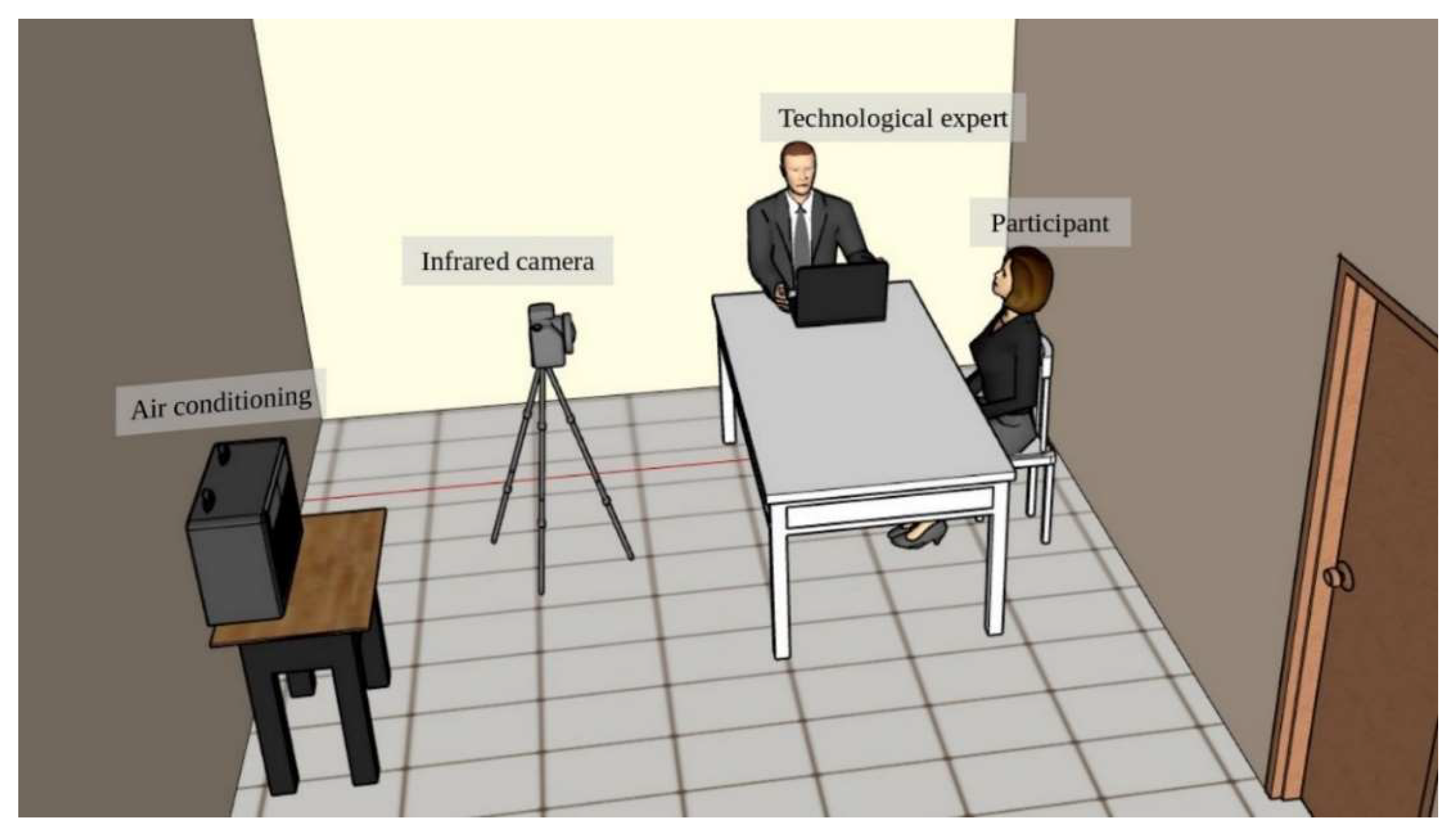
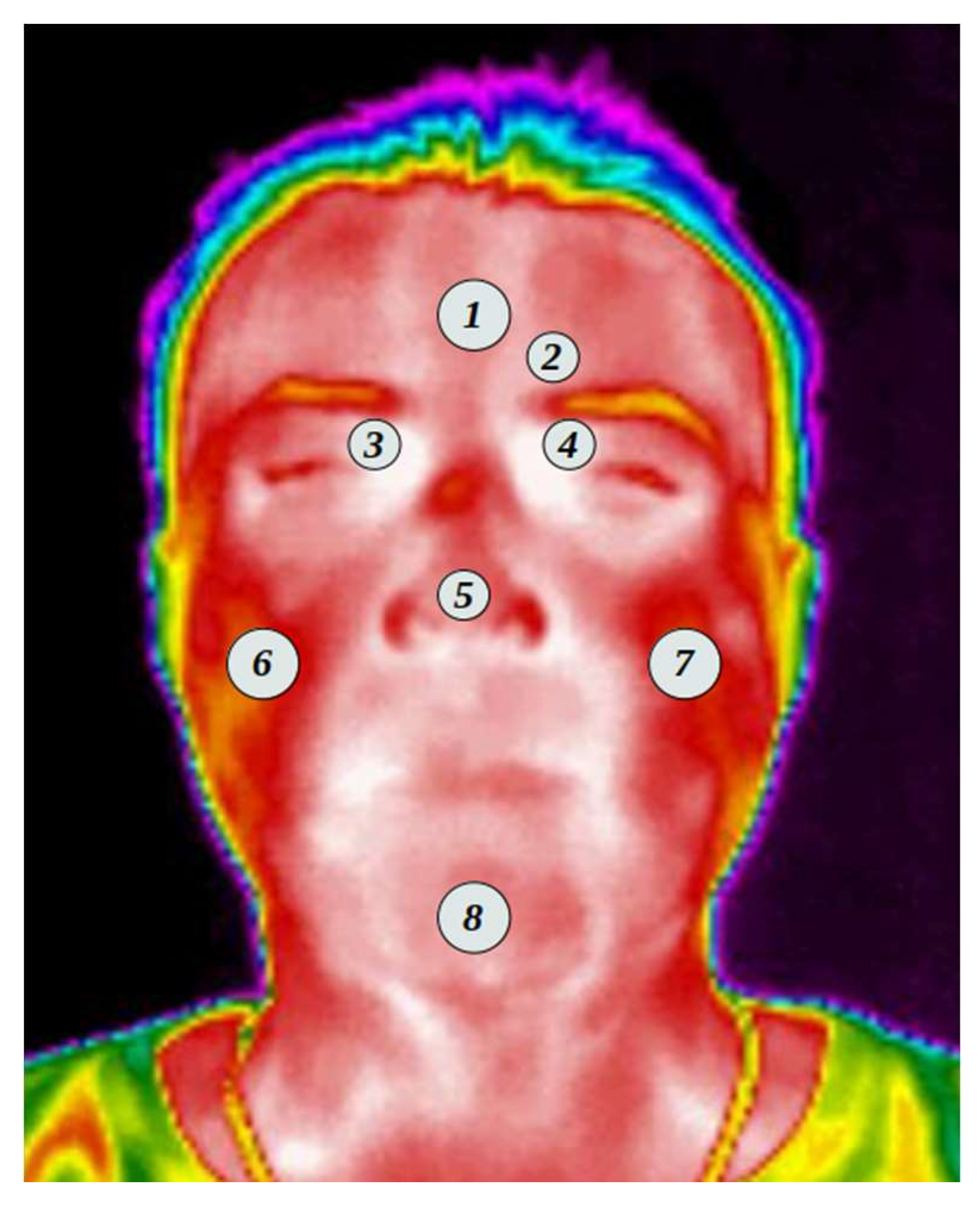
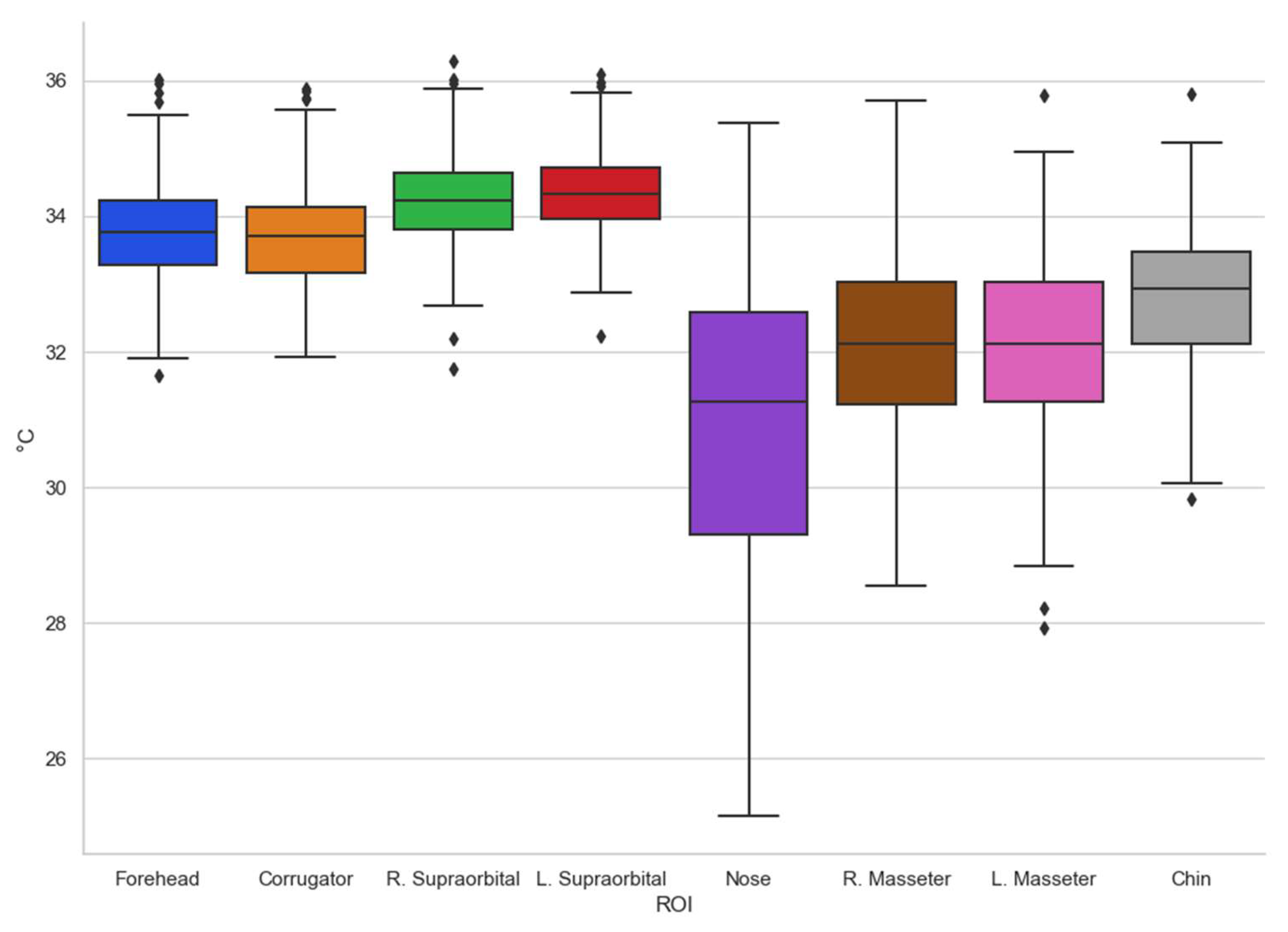


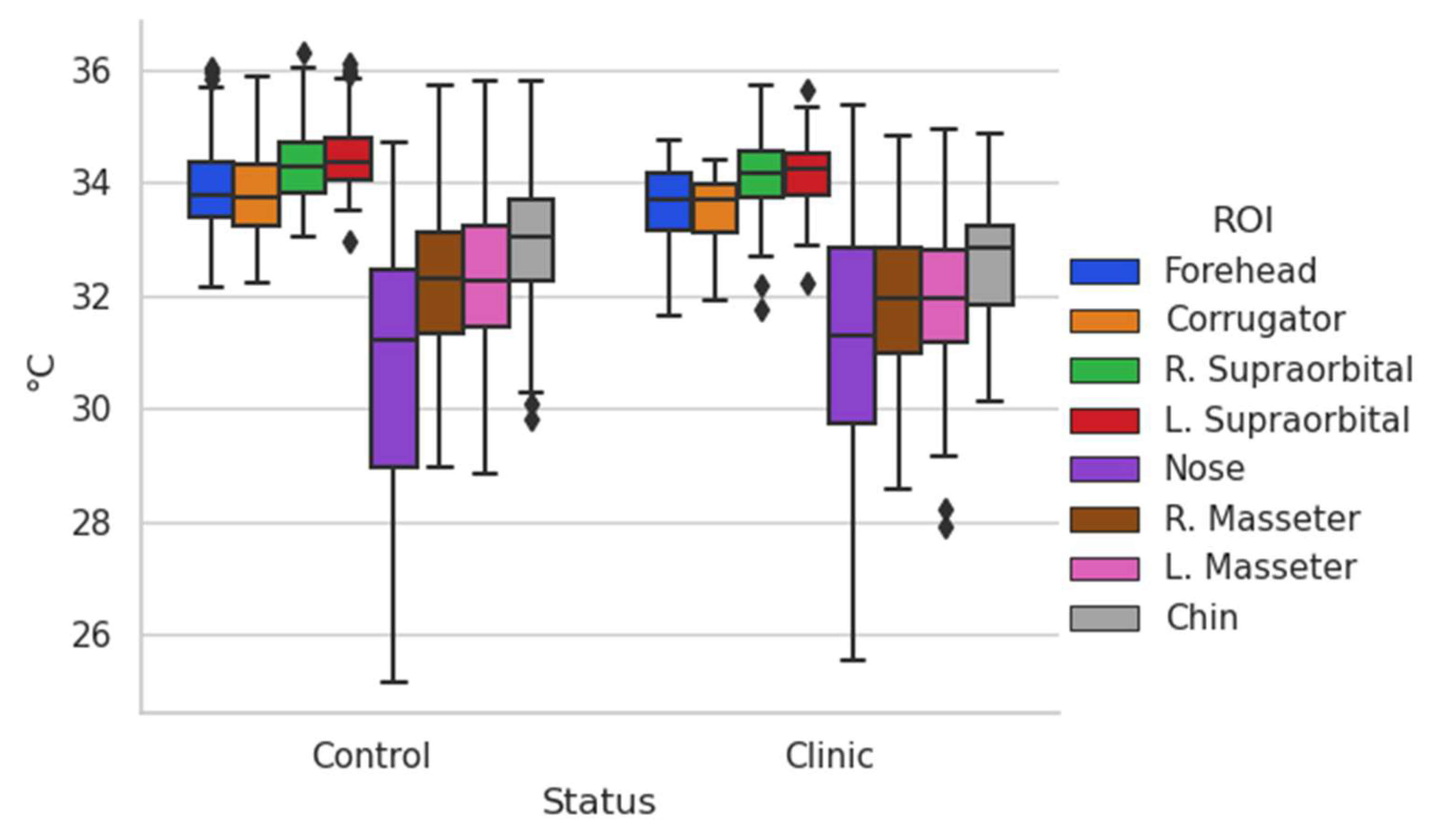
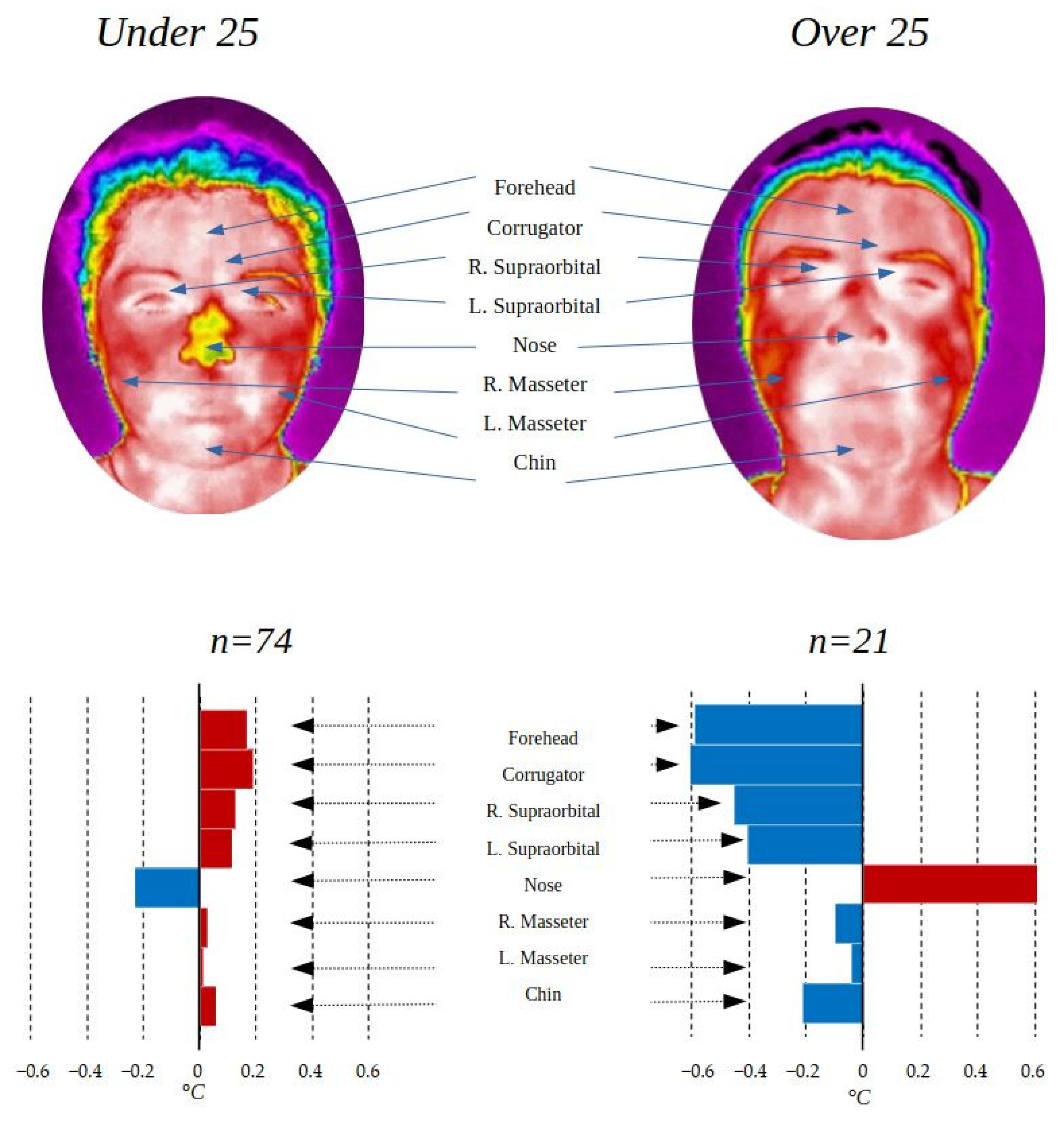
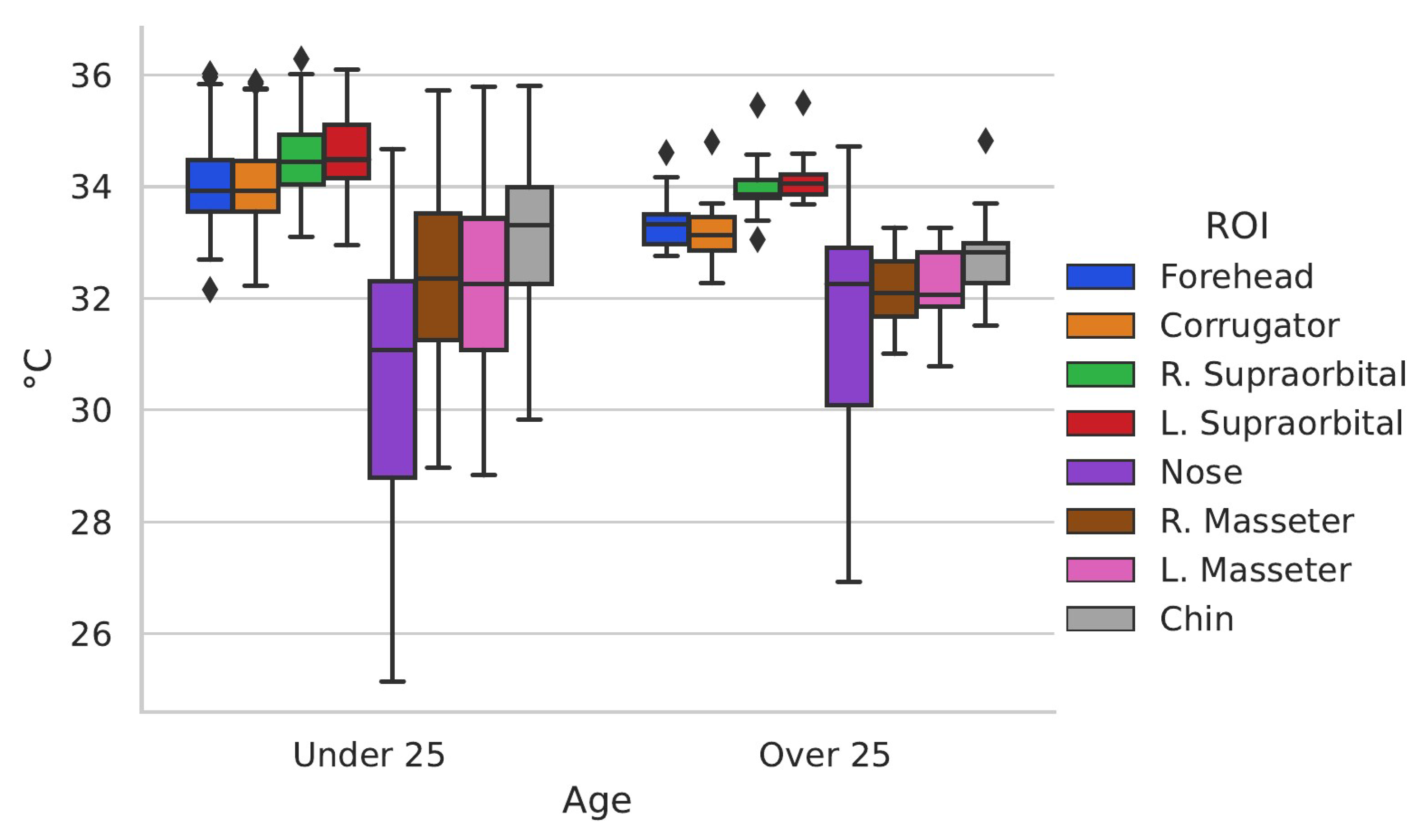
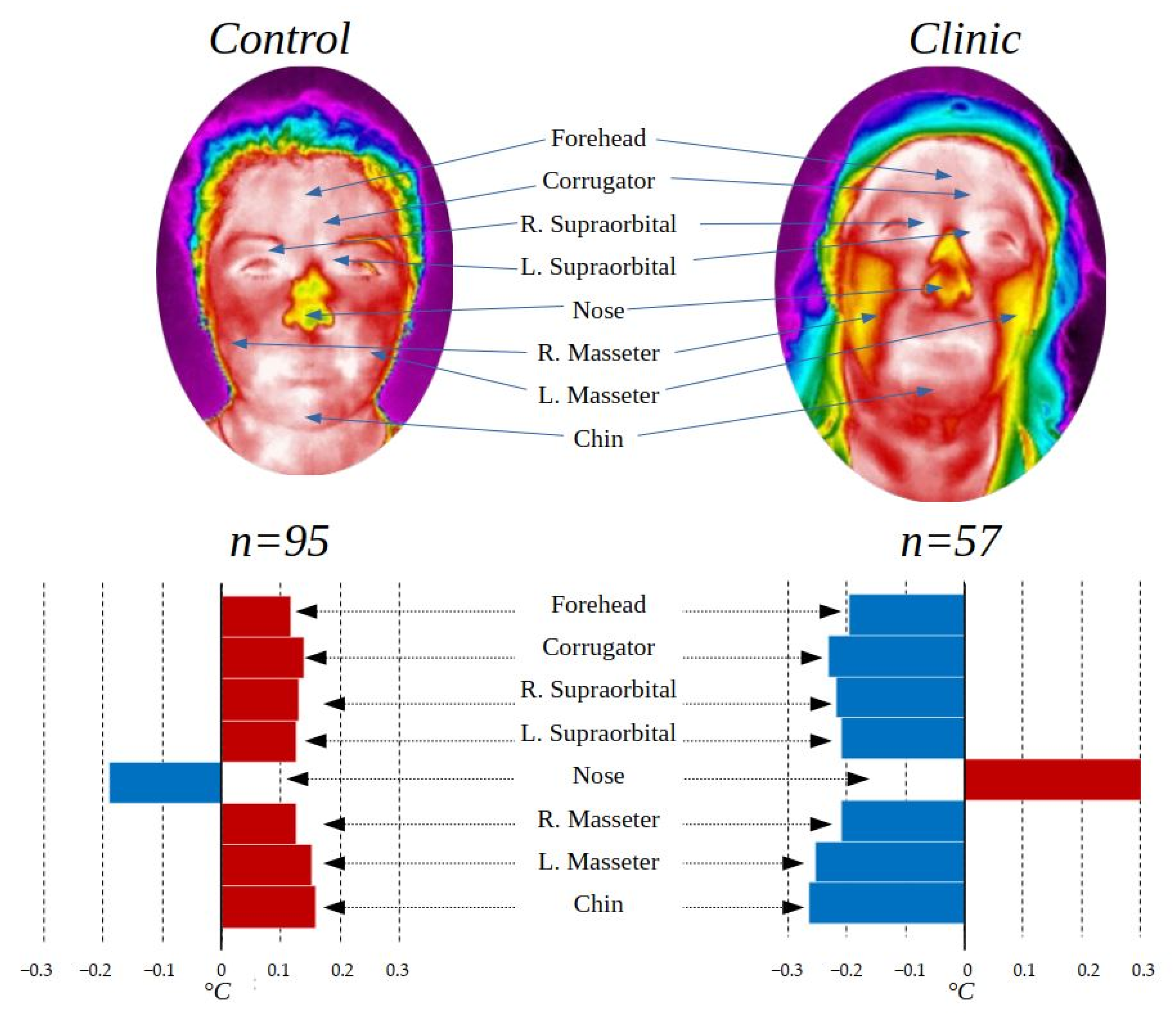
| Data | n | Average Age (Years) | SD |
|---|---|---|---|
| All | 152 | 32.69 | 15.96 |
| Male | 52 | 24.21 | 5.88 |
| Female | 100 | 37.08 | 17.17 |
| Under 25 yo | 81 | 20.91 | 1.91 |
| From 25 to 50 yo | 36 | 33.97 | 7.79 |
| Over 50 yo | 35 | 58.57 | 6.30 |
| Control group | 95 | 22.67 | 3.88 |
| Clinic group | 57 | 49.35 | 14.47 |
| ROI | Mean | SD | Normality Test |
|---|---|---|---|
| Forehead | 33.80 | 0.76 | p > 0.05 |
| Corrugator | 33.70 | 0.80 | p > 0.05 |
| Right Supraorbital | 34.27 | 0.74 | p = 0.01 |
| Left Supraorbital | 34.39 | 0.67 | p = 0.00 |
| Nose | 30.82 | 2.39 | p = 0.00 |
| Right masseter | 32.12 | 1.38 | p > 0.05 |
| Left masseter | 32.11 | 1.41 | p > 0.05 |
| Chin | 32.80 | 1.15 | p = 0.00 |
| ROI | Male | Female | p | r | ||
|---|---|---|---|---|---|---|
| Mean | SD | Mean | SD | |||
| Forehead | 33.73 | 0.68 | 34.10 | 0.84 | 0.02 | −0.23 |
| Corrugator | 33.58 | 0.73 | 34.10 | 0.88 | <0.01 | −0.30 |
| Right Supraorbital | 34.25 | 0.69 | 34.56 | 0.77 | 0.04 | −0.20 |
| Left Supraorbital | 34.40 | 0.63 | 34.64 | 0.71 | 0.07 | −0.18 |
| Nose | 30.77 | 2.42 | 30.50 | 2.47 | 0.59 | 0.05 |
| Right masseter | 32.27 | 1.35 | 32.22 | 1.46 | 0.87 | 0.01 |
| Left masseter | 32.29 | 1.29 | 32.22 | 1.48 | 0.80 | 0.02 |
| Chin | 32.74 | 1.13 | 33.18 | 1.21 | 0.07 | −0.18 |
| ROI | Under 25 | Over 25 | ||||
|---|---|---|---|---|---|---|
| Mean | SD | p | r | Mean | SD | |
| Forehead | 34.08 | 0.78 | <0.01 | 0.40 | 33.32 | 0.45 |
| Corrugator | 34.02 | 0.84 | <0.01 | 0.41 | 33.18 | 0.50 |
| Right Supraorbital | 34.53 | 0.76 | <0.01 | 0.32 | 33.95 | 0.49 |
| Left Supraorbital | 34.63 | 0.70 | <0.01 | 0.31 | 34.11 | 0.39 |
| Nose | 30.40 | 2.47 | 0.08 | −0.17 | 31.45 | 2.18 |
| Right masseter | 32.27 | 1.55 | 0.72 | 0.03 | 32.15 | 0.69 |
| Left masseter | 32.27 | 1.53 | 0.87 | 0.01 | 32.22 | 0.64 |
| Chin | 33.02 | 1.29 | 0.35 | 0.09 | 32.75 | 0.69 |
| ROI | Control | Clinic | p | r | ||
|---|---|---|---|---|---|---|
| Mean | SD | Mean | SD | |||
| Forehead | 33.91 | 0.78 | 33.60 | 0.68 | 0.01 | 0.19 |
| Corrugator | 33.84 | 0.85 | 33.46 | 0.66 | <0.01 | 0.22 |
| Right Supraorbital | 34.40 | 0.75 | 34.05 | 0.69 | 0.06 | −0.14 |
| Left Supraorbital | 34.52 | 0.67 | 34.18 | 0.61 | 0.02 | −0.18 |
| Nose | 30.63 | 2.44 | 31.14 | 2.30 | 0.25 | 0.09 |
| Right masseter | 32.24 | 1.40 | 31.91 | 1.33 | 0.14 | 0.11 |
| Left masseter | 32.26 | 1.38 | 31.85 | 1.43 | 0.08 | 0.13 |
| Chin | 32.96 | 1.18 | 32.54 | 1.04 | 0.02 | −0.17 |
Publisher’s Note: MDPI stays neutral with regard to jurisdictional claims in published maps and institutional affiliations. |
© 2022 by the authors. Licensee MDPI, Basel, Switzerland. This article is an open access article distributed under the terms and conditions of the Creative Commons Attribution (CC BY) license (https://creativecommons.org/licenses/by/4.0/).
Share and Cite
Jaramillo-Quintanar, D.; Cruz-Albarran, I.A.; Dominguez-Trejo, B.; Rodriguez-Medina, D.A.; Morales-Hernandez, L.A. Face Thermal Map of the Mexican Population in the Basal State. Int. J. Environ. Res. Public Health 2022, 19, 14208. https://doi.org/10.3390/ijerph192114208
Jaramillo-Quintanar D, Cruz-Albarran IA, Dominguez-Trejo B, Rodriguez-Medina DA, Morales-Hernandez LA. Face Thermal Map of the Mexican Population in the Basal State. International Journal of Environmental Research and Public Health. 2022; 19(21):14208. https://doi.org/10.3390/ijerph192114208
Chicago/Turabian StyleJaramillo-Quintanar, Daniel, Irving A. Cruz-Albarran, Benjamin Dominguez-Trejo, David A. Rodriguez-Medina, and Luis Alberto Morales-Hernandez. 2022. "Face Thermal Map of the Mexican Population in the Basal State" International Journal of Environmental Research and Public Health 19, no. 21: 14208. https://doi.org/10.3390/ijerph192114208
APA StyleJaramillo-Quintanar, D., Cruz-Albarran, I. A., Dominguez-Trejo, B., Rodriguez-Medina, D. A., & Morales-Hernandez, L. A. (2022). Face Thermal Map of the Mexican Population in the Basal State. International Journal of Environmental Research and Public Health, 19(21), 14208. https://doi.org/10.3390/ijerph192114208







